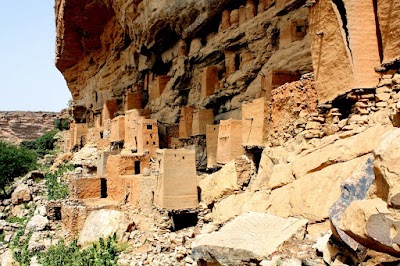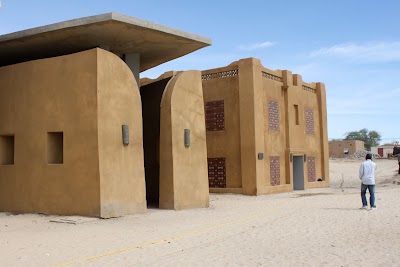Cliffs of Bandiagara (منحدرات باندياغارا)
Overview
The Cliffs of Bandiagara, nestled in the Taoudénit Region of Mali, are a stunning natural marvel that seamlessly merges breathtaking geological formations with a rich tapestry of human history. Recognized as a UNESCO World Heritage Site in 1989, this remarkable cliff range extends over 150 kilometers and reaches heights of nearly 500 meters in certain places, offering awe-inspiring vistas and a deep sense of timelessness.
Dating back to the 15th century, the Cliffs of Bandiagara are intrinsically tied to the Dogon people, one of Africa’s most intriguing indigenous groups. The Dogon migrated to this region to escape Islamic persecution, finding sanctuary in the natural fortresses offered by the cliffs. Over centuries, they constructed unique mud-brick structures and granaries into the cliff faces, giving rise to small, isolated villages that have largely remained unchanged over time. This architecture is not merely functional; it is expertly integrated into the environment, showcasing the remarkable ingenuity and craftsmanship of the Dogon.
The Dogon culture is rich with traditions, myths, and distinctive religious practices. One of the most captivating aspects for visitors is the elaborate masked dances, which are performed during significant ceremonies and rituals. The masks, representing animals, ancestors, and mythological beings, are believed to facilitate communication between the living and the spiritual realm. Witnessing a Dogon masked dance is akin to stepping back in time, providing a rare insight into a way of life that has persisted for centuries despite external influences.
Another fascinating element of the Cliffs of Bandiagara is the ancient Tellem people, who inhabited the area before the Dogon. The Tellem left behind intriguing remnants, including cave dwellings and elaborate burial sites carved into the cliffs. Although the Tellem mysteriously disappeared around the 13th century, their legacy lingers through the archaeological evidence they left behind. For history enthusiasts, exploring these ancient sites adds an extra layer of intrigue to the cliffs.
For the adventurous traveler, the Cliffs of Bandiagara provide a paradise for trekking and exploration. Numerous trails weave through the cliffs and Dogon villages, catering to both seasoned adventurers seeking strenuous hikes and casual explorers desiring leisurely walks. The most popular treks often span several days, allowing visitors to immerse themselves in the stunning landscape while learning about Dogon culture from local guides. Many of these guides are Dogon themselves, sharing authentic and insightful narratives that bring the area’s history to life.
The natural environment surrounding the Cliffs of Bandiagara is equally enchanting. Characterized by a Sahelian climate, the region experiences dramatic seasonal changes that alter the landscape's appearance. During the rainy season, the cliffs are cloaked in lush greenery, whereas the dry season reveals the stark, rugged beauty of the rock formations. Wildlife enthusiasts will also be delighted to discover a variety of flora and fauna, including endemic species that have adapted to the unique conditions of the cliffs.
Despite its remote location, reaching the Cliffs of Bandiagara is an adventure in itself. Many travelers opt to journey from the nearby city of Mopti, often dubbed the "Venice of Mali" for its vibrant river market and network of canals. From Mopti, a 4x4 vehicle is typically required to navigate the arid landscape and reach the cliffs, offering a glimpse into the vastness and isolation that characterizes much of Mali.
Visiting the Cliffs of Bandiagara is more than a visual feast; it’s an opportunity to connect deeply with an area steeped in history and cultural significance. The stark beauty of the cliffs, combined with the rich traditions of the Dogon people, creates an unforgettable experience that lingers in the memory. As you stroll through ancient villages, witness traditional ceremonies, and stand at the edge of towering precipices, you will find that the Cliffs of Bandiagara represent not just a destination, but a profound journey through time and culture.







